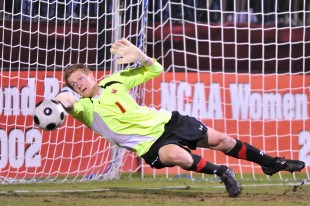Since the first MLS draft in 1996, ten goalies have been drafted in the first round.
The results are decidedly mixed.
While some first rounders have been productive and others have been duds, no goalie selected in round one has had a long and influential career for the team that picked him. Brad Guzan for Chivas and Matt Jordan for Dallas have come closest to fulfilling their promise as long-term number ones. Stefan Frei shows promise in Toronto, but he will have to be superhuman to take that team anywhere in the next few seasons.
MacMath for the Union?
MLSNet’s draft experts list Maryland goalkeeper Zac MacMath anywhere from the third to the eleventh best player available in the 2011 SuperDraft. This puts him firmly in the Philadelphia Union’s sights on draft day. After a series of re-entry draft deals, the Union ended up with empty pockets and the last Maryland goalie drafted in the first round – Chris Seitz – ended up in Dallas.
The Union need a goalie now, and MacMath is the only one considered pro-ready. But it is difficult to move between leagues, let alone make the leap from college to professional soccer. The bald truth is that a draft pick used on a first round goalie has never been worth it’s value. Even the talented Guzan only spent four seasons at Chivas before leaving for England. If Chivas could pick again, would they spend a number two pick on one dominant year of goalkeeping?
The draft is not the place to fix problems in net
The talent level in MLS has grown at a near exponential rate, but that cannot mask the major issue with the SuperDraft: many of the best players in college soccer are unknown quantities at the professional level.
MLS shares this problem with the NBA, where players who go pro after their freshman year tend to be booms or busts. Or they show up five years later after developing a pro game abroad or in the D-League. The NBA has to deal with this when 19-year-olds enter the draft. Unfortunately, the fact that upperclassmen are still struggling mightily to adapt to the pro game is a knock against college soccer and the US youth system. While other countries often see their stars make the leap from very-good to all-world in their late teens, the US often doesn’t know what it has until players are in their early to mid-twenties.
Simply put, the game young US players are playing in college is markedly different from the one they find at a pro level.
All of this is to say that the SuperDraft is much more of a close-your-eyes-and-swing affair than anybody would like to admit. For instance, a look at success in drafting goalies produces the same mixed bag as a study of number five picks.
Looking ahead
The Union should continue their policy from 2010 and draft according to future value. There are no guaranteed quick-fixes in the SuperDraft, and that guarantee is the only reason for Philly to draft a goalie early.
Rather, the team should look to Vancouver as an example of how to develop goalkeeping talent. The Whitecaps jumped on former second round SuperDraft pick Jay Nolly when he was out of MLS. Nolly has led the Vancouver back line for three years now, and has found the confidence he had as a collegiate at Indiana University. His is a story that Chris Seitz may need to emulate if he wants to establish a starting job in the future.
Img via Testudo Times


Vancouver has such confidence in Jay Nolly that they acquired Joe Cannon to be the #1 now that they are in MLS.
Joe Cannon was undrafted and had to work his way to MLS via the A-League San Diego Flash. Same point, different goalie. Look for goalies who are succeeding in professional leagues instead of grabbing them out of college.
You mean like Faryd Mondragon?